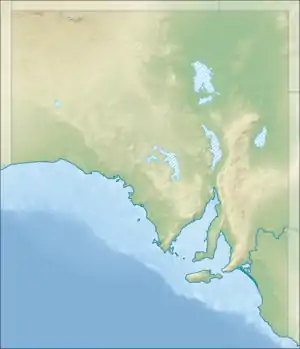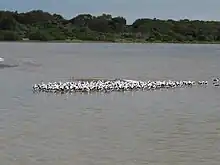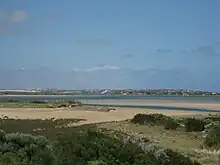| Coorong National Park South Australia | |
|---|---|
 The view across the Coorong near Salt Creek | |
 A map of the Coorong | |
 Coorong National Park | |
| Nearest town or city | Goolwa |
| Coordinates | 36°02′57″S 139°33′13″E / 36.04917°S 139.55361°E |
| Established | 9 November 1967[2] |
| Area | 490.15 km2 (189.2 sq mi)[3] |
| Managing authorities | Department for Environment & Water |
| Website | Coorong National Park |
| Footnotes | |
| Official name | The Coorong, Lake Alexandrina & Albert Wetland |
| Designated | 1 November 1985 |
| Reference no. | 321[4] |
| See also | Protected areas of South Australia |
Coorong National Park is a protected area located in South Australia about 156 kilometres (97 mi) south-east of Adelaide, that predominantly covers a coastal lagoon ecosystem officially known as The Coorong and the Younghusband Peninsula on the Coorong's southern side. The western end of the Coorong lagoon is at the Murray Mouth near Hindmarsh Island and the Sir Richard Peninsula, and it extends about 130 kilometres (81 mi) south-eastwards. Road access is from Meningie. The beach on the coastal side of the peninsula, the longest in Australia, is also commonly called The Coorong.
The Coorong lies within the traditional lands of the Ngarrindjeri people, an Aboriginal Australian group. Notable locations within the park include Salt Creek, Policeman's Point, Jack Point, and Woods Well.




Etymology
Its name is thought to be a corruption of the Ngarrindjeri word kurangk, also written Kurangh, meaning a long or narrow lagoon or neck [5][6][7]
History
The Coorong National Park was proclaimed on 9 November 1967 under the National Parks Act 1966 in respect to land in sections 17 and 60 in the cadastral unit of the Hundred of Glyde and section 6 in the Hundred of Santo.[2]
At the commencement of the National Parks and Wildlife Act 1972 on 27 April 1972, the national park consisted of land in sections 17, 59 and 60 in the cadastral unit of the Hundred of Glyde and sections 6, 43 and 52 in the Hundred of Santo.[8]
The Coorong Game Reserve which was purchased by the Government of South Australia in 1968 was abolished on 14 January 1993 and its lands was added to the national park.[9] The game reserve occupied part of the Coorong lagoon to the immediate west of Salt Creek and had an area of 68.4 square kilometres (26.4 sq mi) as of May 1982.[10]: 79
In February 2013, a lifeboat from MS Oliva, a ship that foundered in the South Atlantic during 2011, washed up on a beach in the national park.[11]
Description
The western end of the Coorong lagoon is at the Murray Mouth near Hindmarsh Island and the Sir Richard Peninsula, and it extends about 130 kilometres (81 mi) south-east. The national park area includes the Coorong itself, and Younghusband Peninsula which separates the Coorong from Gulf St Vincent in the Southern Ocean. The Coorong has been cut off from Lake Alexandrina by the construction of the Goolwa Barrages (weirs) from Goolwa to Pelican Point during the late 1930s.[12]
The national park was formed in 1967 as a sanctuary for many species of birds, animals and fish. It attracts many migratory species. It provides refuge for these animals during some of Australia's regular droughts. The 467 square kilometres (180 sq mi) also supports coastal dune systems, lagoons and coastal vegetation.[13]
One of the unique aspects of the Coorong is the interaction of water along its length, with sea water and Murray River water meeting rainfall and groundwater. The freshwater supports the fauna (animal) of the area while the sea water is the habitat for much of the birdlife.[14]
Notable locations within the park include Salt Creek, Policeman's Point, Jack Point, and Woods Well.[15]
The waters of the Coorong are a popular venue for recreational and commercial fishers. Coorong mullet, mulloway and bream are the main species.[15][6]
Beach
The 194 km (121 mi) long sandy beach running down the outer side of the Younghusband Peninsula and commonly referred to as The Coorong, is the longest beach in Australia. It runs from the Murray mouth to Cape Jaffa.[16]
Cultural significance
The Coorong is of great cultural significance to the Ngarrindjeri people, who have songlines relating to creation stories associated with the area as well as a long history of living sustainably and looking after the complex environment.[17]
Camp Coorong
Camp Coorong is a place of cultural learning, where visitors can learn about Ngarrindjeri culture, history, arts and crafts, including basket-weaving. It is owned and run by Ngarrindjeri people, and situated about 11 km (6.8 mi) south of Meningie.[6] The centre was founded by brothers Tom and George Trevorrow in 1985, with the aim of creating a place where the local community could have camps, younger members of the community might find employment, and Ngarrindjeri culture could be shared. It was officially closed to the public in 2018.[18]
Ngarrindjeri elder and well-known weaver Aunty Ellen Trevorrow, who is Tom's widow, works from one of the rooms at the camp, along with artist and academic Jelina Haines, who was born in the Philippines. Their work has been commissioned for the recently refurbished Department for Infrastructure & Transport offices in Pirie Street.[18]
Ecology
The wetlands within the part of the national park containing the Coorong Lagoon form a complex ecosystem of freshwater, estuarine, and hypersaline waterbodies with a unique diversity of habitats for plants and animals. The coastal lagoons are considered critically endangered due to the loss of freshwater flows, local extinction of characteristic submerged plants and subsequent loss of habitat diversity.[19]
In December 2018, the Federal and South Australian governments announced a new environmental management program called "Healthy Coorong, Healthy Basin".[20] Ongoing as of 2021, the Ngarrindjeri Aboriginal Corporation is working with the Department for Environment & Water to share their knowledge of landcare practices, which will be incorporated in a new database.[17]
Flora and fauna
The Coorong is an area of huge natural biodiversity.[17]
Birds
The Coorong National Park has been recognised by BirdLife International as an Important Bird Area. It has supported the chestnut teal, Australian shelduck, sharp-tailed sandpiper, red-necked stint, banded stilt, red-necked avocet, pied oystercatcher and red-capped plover. Australasian bitterns have been recorded. It has also supported significant numbers of orange-bellied parrots, fairy terns and hooded plovers, although their usage of the site has declined from reduced freshwater inflows.[21]
The largest pelican rookery in Australia is at Jack Point, just off the Princes Highway and about 7 km (4.3 mi) north of Salt Creek.[6] The pelicans also breed on North Pelican Island.[17] The Australian pelican (Pelecanus conspicillatus) is the largest species of pelican, and breeds from August until January.[6]
Marine life
As mentioned above, Coorong mullet, mulloway and bream are the main species caught for human consumption in the Coorong.[15][6]
In the arts
The park was the setting of the popular 1976 film Storm Boy,[22] as well as its 2019 remake. Both films are based on the 1964 novel by Colin Thiele of the same name set on the Coorong that portrays the bond of a young boy who rescues and raises an extraordinary orphaned pelican which he names Mr Percival.[23][22]
Lucy Treloar's award-winning novel, Salt Creek (2015), is set in the Coorong, specifically the area around Salt Creek, in 1855.[24]
See also
References
- ↑ "Terrestrial Protected Areas of South Australia (refer 'DETAIL' tab )". CAPAD 2016. Australian Government, Department of the Environment (DoE). 2016. Retrieved 21 February 2018.
- 1 2 Walsh, Frank (9 November 1967). "NATIONAL PARKS ACT, 1966: VARIOUS NATIONAL PARKS NAMED" (PDF). South Australian Government Gazette. South Australian Government. p. 2043. Retrieved 17 March 2018.
- ↑ "Protected Areas Information System Reserve List" (PDF). Government of South Australia. 9 March 2018. Retrieved 26 April 2018.
- ↑ "The Coorong, Lake Alexandrina & Albert Wetland". Ramsar Sites Information Service. Retrieved 25 April 2018.
- ↑ Mosley, Luke; Ye, Qifeng; et al., eds. (2018). Natural History of the Coorong, Lower Lakes, and Murray Mouth Region (yarluwar-ruwe) (PDF). University of Adelaide Press on behalf of Royal Society of South Australia. p. 78. ISBN 978-1-925261-81-3. Retrieved 7 August 2021.
- 1 2 3 4 5 6 "Coorong, The, SA". Aussie Towns. Retrieved 6 August 2021.
- ↑ "6 things you might not know about the Coorong". Good Living. Department for Environment & Water. Retrieved 6 August 2021.
- ↑ "No. 56 of 1972 (National Parks and Wildlife Act, 1972)". The South Australian Government Gazette. Government of South Australia: 700. 27 April 1972. Retrieved 20 January 2017.
- ↑ "NATIONAL PARKS AND WILDLIFE ACT 1972 PART HI: RECONSTITUTION OF THE COORONG GAME RESERVE AS PART OF THE COORONG NATIONAL PARK" (PDF). The South Australian Government Gazette. Government of South Australia: 170. 14 January 1993. Archived (PDF) from the original on 28 June 2023. Retrieved 7 January 2018.
- ↑ Rudduck, Penny (May 1982). EUROPEAN HERITAGE OF THE COORONG, A general survey of the sites of Early European Heritage of the area now comprising the Coorong National Park and Coorong Game Reserve (PDF) (Report). National Parks and Wildlife Service, Government of South Australia. Retrieved 6 January 2018.
- ↑ "Shipwreck lifeboat washes up in Australia". ABC News Online. Australian Broadcasting Corporation. 6 February 2013. Retrieved 7 May 2019.
- ↑ Map of the Coorong Accessed 3/3/7
- ↑ Coorong National Park Archived 20 October 2009 at the Wayback Machine – Things to see and do, Accessed 30/7/9
- ↑ Coorong National Park Archived 21 October 2009 at the Wayback Machine – Natural Attractions, Accessed 30/7/9
- 1 2 3 "Coorong, The". Sydney Morning Herald. 8 February 2004. Retrieved 7 August 2021.
- ↑ "Beach in Policeman Point The Coorong SA". SLS Beachsafe. 2 November 2015. Retrieved 7 August 2021.
- 1 2 3 4 Green, Selina (2 August 2021). "Coorong Landcare project embraces Ngarrindjeri knowledge, cultural connection". ABC News. Australian Broadcasting Corporation. Retrieved 7 August 2021.
- 1 2 Marsh, Walter (7 October 2022). "In the studio with Aunty Ellen Trevorrow". InDaily. Retrieved 9 October 2022.
- ↑ Keith, DA; Rodríguez, J.P.; et al. (2013). "Scientific Foundations for an IUCN Red List of Ecosystems". PLOS ONE. 8 (5): e62111. Bibcode:2013PLoSO...862111K. doi:10.1371/journal.pone.0062111. PMC 3648534. PMID 23667454. Archived from the original on 28 October 2020. Retrieved 8 September 2018.
- ↑ "Healthy Coorong, Healthy Basin". Department for Environment & Water. Retrieved 8 August 2021.
- ↑ "Important Bird Areas factsheet: Coorong". BirdLife International. 2016. Retrieved 3 December 2016.
- 1 2 "Storm Boy remake planned 40 years after original award-winning film". ABC News. Australian Broadcasting Corporation. 18 November 2016. Retrieved 6 August 2021.
- ↑ "IMDB - Storm Boy (2019)". IMDb.
- ↑ Treloar, Lucy (18 August 2020). "Salt Creek". Pan Macmillan. Retrieved 7 August 2021.
Further reading
- Mosley, Luke; Ye, Qifeng; et al., eds. (2018). Natural History of the Coorong, Lower Lakes, and Murray Mouth Region (yarluwar-ruwe) (PDF). University of Adelaide Press on behalf of Royal Society of South Australia. ISBN 978-1-925261-81-3.
External links
- "Coorong National Park". National Parks and Wildlife Service South Australia. Department for Environment & Water.
- "Coorong National Park". Coorong Country.
![]() Media related to Coorong National Park at Wikimedia Commons
Media related to Coorong National Park at Wikimedia Commons